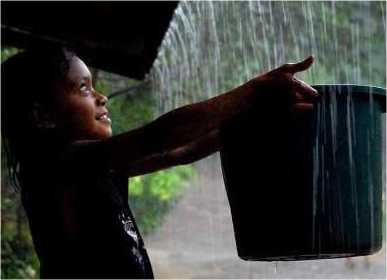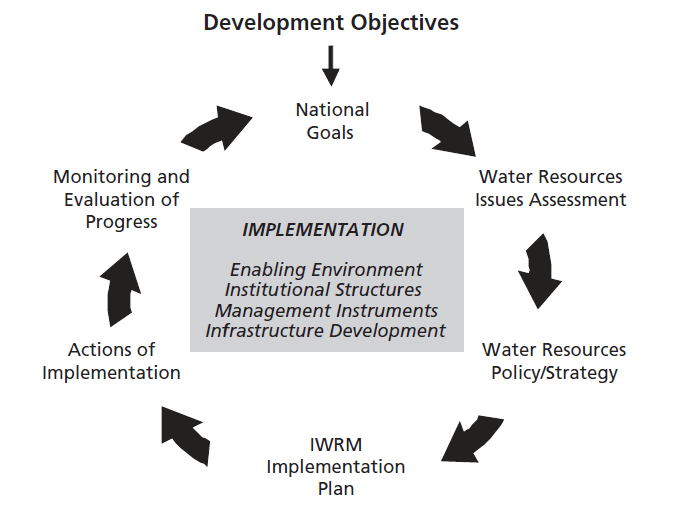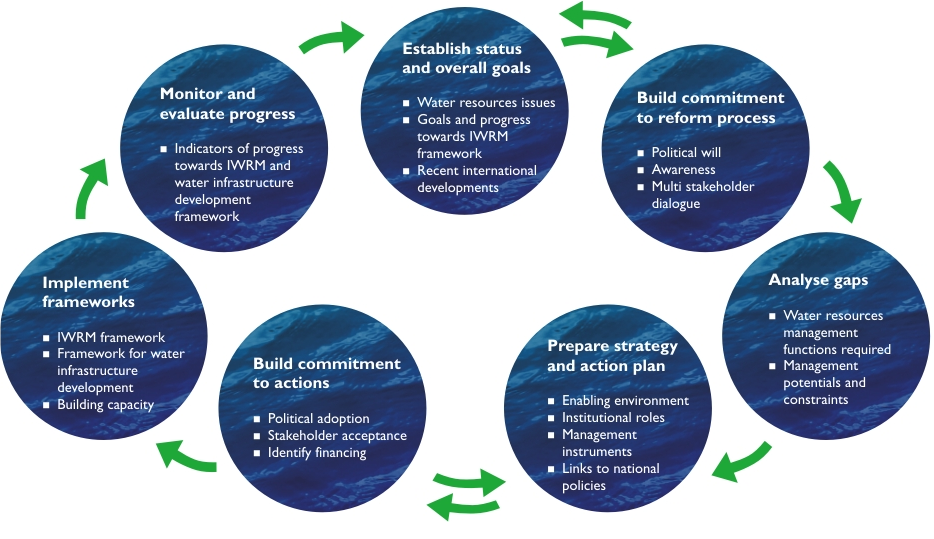Integrated Water Resources Management (IWRM)
IWRM is based on the understanding that water resources are an integral component of the ecosystem, a natural resource, and a social and economic good. Managers, whether in the government or private sectors, have to make difficult decisions on water allocation. More and more they have to apportion diminishing supplies between ever-increasing demands. Drivers such as demographic and climatic changes further increase the stress on water resources. The traditional fragmented approach is no longer viable and a more holistic approach to water management is essential.
This is the rationale for the Integrated Water Resources Management (IWRM) approach that has now been accepted internationally as the way forward for efficient, equitable and sustainable development and management of the world's limited water resources and for coping with conflicting demands.
WRM is an empirical concept which was built up from the on-the-ground experience of practitioners. Although many parts of the concept have been around for several decades - in fact since the first global water conference in Mar del Plata in 1977 - it was not until after Agenda 21 and the World Summit on Sustainable Development in 1992 in Rio that the concept was made the object of extensive discussions as to what it means in practice. The Global Water Partnership's definition of IWRM is widely accepted. It states: 'IWRM is a process which promotes the co-ordinated development and management of water, land and related resources, in order to maximize the resultant economic and social welfare in an equitable manner without compromising the sustainability of vital ecosystems.'
IWRM Principles
IWRM strategies are based on the four Dublin Principles presented at the World Summit in Rio de Janeiro in 1992.
1. Water is finite and vulnerable resource
Fresh water is a finite resource. This is supported by the quantitative review of global water cycle, which suggests a fixed annual volume of water. Fresh water is a natural resource that needs to be maintained by ensuring effective management of water resources. Water is needed for different purposes, functions and services, therefore, water management should be integrated and take account of both demand for and threat to this resource. This principle assigns a river basin or a catchment area to be a water management unit, which is the so-called hydrographical approach to water management.
2. Participatory approach
Water is a resource that affects all. True participation is ensured only when all stakeholders are involved in the decision making. A participatory approach involving all stakeholders is the best strategy to achieve long-term accord and consensus. Participation means taking responsibility for and acknowledging impact of this sector on other water users and water ecosystems as well as committing to increasingly effective use and sustainable development of water resources.
Participation does not necessarily result in consensus, therefore, arbitrage and other conflict resolution mechanisms should be ensured. Governments should work to ensure participation of all stakeholders, in particular, vulnerable groups of the population. Poor groups of the population will benefit least from a mere participatory environment without enhanced participation mechanisms. Decentralizing decision making to the lowest level is the only strategy to enhance participation.
3. Role of women
It is generally accepted that women play a key role in the collection and safeguarding of water for domestic purposes and, in many instances, agricultural use. At the same time, women play a less powerful role than men in the management, problem analysis and decision making related to water. IWRM demands the role of women to be acknowledged. This is also referred to as gender mainstreaming.
In order to ensure full and effective participation of women at all levels of decision making, account should be taken of approaches that public agencies use to assign social, economic and cultural functions to men and women. There is an important link between gender equality and sustainable water management. Participation of men and women playing a decision making role at all levels of water management can expedite the achievement of sustainability, while integrated and sustainable water resources management greatly contributes to gender equality by improving access of both women and men to water and water-related services, thus serving their daily needs.
4. Social and economic value of water
Within this principle, it is vital to recognize first the basic right of all human beings to have access to clean water and sanitation at an affordable price. Managing water as an economic good is an important way of achieving efficient and equitable use, and of encouraging conservation and protection of water resources. As soon as water is collected from a source, it has a price as an economic and social good. Past failure to effectively manage water resources is associated with failure to recognize the economic value of water. Water cost and charge are two different things that should be clearly differentiated. As a regulating or economic mean, water cost in alternative uses is important to efficiently distribute water as a scarce resource. Water charge is used as an economic tool to support vulnerable groups and influence their water saving and efficient use behaviors by providing incentives to manage demand, cost recovery and readiness of individual users to pay for extra water management services.
Recognizing water as an economic good is a key decision-making tool to distribute water among different sectors of the economy and different users within sectors. It is particularly important when water supply cannot be increased.
5. Integrating three Es
Integrated water resources management is based on the equitable and efficient management and sustainable use of water. It recognises that water is an integral part of the ecosystem, a natural resource, and a social and economic good, whose quantity and quality determine the nature of its utilisation.
IWRM Planning Cycle
Field experiences
Promoting IWRM and Fostering Transboundary Dialogue in Central Asia. This project aims to support more sustainable and efficient management of water resources in the region as well as to enhance cooperation between the states on water management-related issues through interventions at the national level (mainly Kyrgyzstan and Tajikistan), and at the transboundary level (mainly Kazakhstan).
- This project builds upon earlier initiatives in the partner countries, leveraging successful projects and experiences to further advance the principles of Integrated Water Resource Management (IWRM).
- It is implemented by the UNDP Bratislava Regional Center through its Regional Office in Almaty as well as the UNDP Country Offices in Kazakhstan, Kyrgyzstan, and Tajikistan.
- The total budget of the project is USD 5.4 million, including in-kind contributions. The financing partners are the European Union, contributing EUR 1.5 million, Finland and ENVSEC.
Acknowledgements
- Integrated Water Resources Management (IWRM). UN Water.
- What is IWRM?. GWP.








